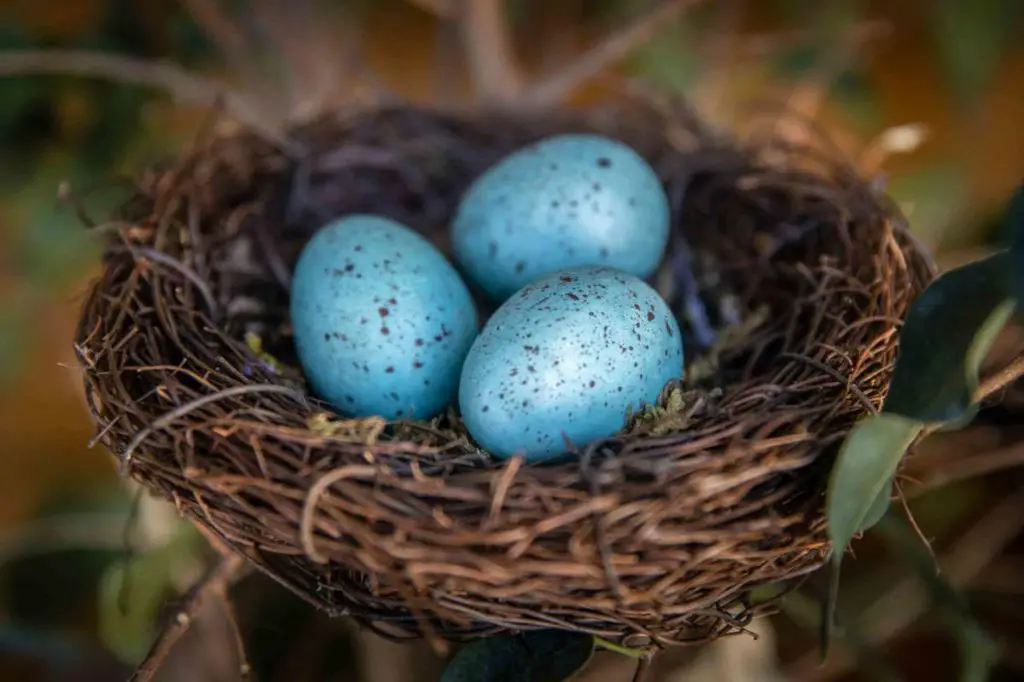What Colour Are Robin Eggs?
The American robin (Turdus migratorius) is a common and familiar bird known for its iconic red-orange breast and cheerful song. Robins are medium-sized songbirds that can be found across North America. They are one of the earliest birds to lay eggs, typically building nests and breeding in spring. The robin’s blue eggs are well-known and easily recognizable.
In this article, we will take a closer look at the natural history of robins, their nests, eggs, incubation and hatching process, fledging of chicks, and potential threats these birds face. We will also examine the specific color of robin eggs and what purpose it serves.
Robin Natural History
American robins (Turdus migratorius) are common birds found across North America (Source). They inhabit open woodlands, lawns, fields, parks, and backyards. Robins are omnivorous and eat a variety of foods including earthworms, insects, fruits, and berries. Their diet changes with the seasons. In spring and summer, they mainly eat insects and earthworms. In fall and winter, they shift to eating more fruits and berries (Source).
The American robin goes through multiple life stages. Females typically lay 3-5 eggs at a time and may have up to 3 broods per year. The eggs incubate for 12-14 days before hatching. Baby robins are altricial, meaning they hatch helpless and require extensive parental care. Parents feed the nestlings regurgitated food for about 2 weeks before they fledge and leave the nest. Juvenile robins reach reproductive maturity after 1 year. In the wild, robins have an average lifespan of 2 years but can live up to 14 years (Source).
Robin Nests
Robins build nests in trees, on ledges, in gutters, and other manmade structures (Birds and Blooms). They prefer to build nests on horizontal branches or structures in the lower half of trees or up high on buildings (All About Birds). The female robin builds the nest out of grass, dead leaves, moss, and other natural materials (Woodland Trust). She then lines the nest with hair and other soft materials to cushion the eggs. Robins can build a new nest in as little as 1-3 days.
Egg Laying
Robins start laying eggs in March through July. They usually lay 3-4 eggs in a clutch, though they can have as many as 5 eggs. Females lay one egg per day, often around dawn. Robins usually complete a clutch within 3-6 days. According to Journey North, the time between eggs can be affected by weather and available food resources. Robins build an egg cup nest lined with grass or mud where they lay their eggs. They lay pale blue eggs that are 1-1.4 inches long and about .8 inches wide. Female robins incubate the eggs for 12-14 days before they hatch.
Sources:
https://journeynorth.org/robins/resources/article/facts-robin-eggs
https://www.birdsandblooms.com/birding/attracting-birds/bird-nesting/robins-nests-robins-eggs/
Egg Color
Robin eggs are a distinctive blue-green color, often described as “Robin’s Egg Blue.” This characteristic coloration comes from biliverdin, a pigment found in the shells of many bird species’ eggs.
According to the Cracking the mystery of how birds’ eggs are blue, the blue-green biliverdin pigment is deposited into the eggshell as it develops in the female robin’s oviduct. This pigment helps protect the developing chick embryo from sunlight exposure.

The specific “Robin’s Egg Blue” shade is a light cyan or pale turquoise that has become strongly associated with robins. However, it is not exclusive to robins. Many other bird species also lay blue or blue-green eggs, including jays, thrushes, and finches. The vivid blue egg coloration helps camouflage the eggs in the shadowy depths of nests.
While robin eggs are commonly blue-green, some variations can occur. Rarely, some individual robins may lay white or speckled eggs instead of the typical blue eggs.
Incubation
The incubation period for robin eggs is 12-14 days from when the last egg is laid [1]. The female robin does the majority of incubating, sitting on the eggs for up to 50 minutes at a time before taking a brief break [2]. Even in good weather, the female rarely leaves the nest for more than 5-10 minutes. She carefully turns the eggs multiple times a day to ensure even heating and development. Meanwhile, the male robin occasionally incubates for short periods, allowing the female to find food and take longer breaks from the nest. But the female takes on the main responsibility of keeping the eggs warm. Both parents are committed to protecting the nest from predators during incubation.
Hatching
After about 12-14 days of incubation, the robin eggs start to hatch. The eggs hatch over the course of several hours. The chick inside the egg uses its egg tooth to chip a hole in the egg and then continues to chip around the circumference until the shell breaks apart.
Once the chick has hatched, the parents remove the broken shell pieces from the nest. The chicks are altricial, which means they are helpless, blind, and featherless when they first hatch. The parents brood the chicks to keep them warm. They also feed the chicks regurgitated food frequently, sometimes up to 10-12 times per hour.
Within a few days, the chicks open their eyes. They grow quickly, developing feathers within 5-6 days. By two weeks old, they have most of their juvenile plumage. The chicks fledge and leave the nest about 12-16 days after hatching. The parents continue to care for them, feeding them for a couple more weeks while they learn to fly and forage on their own.
Cite: (American Robin Eggs, Journey North)
Fledging
After hatching, baby robins stay in the nest for 9 to 16 days before fledging, or leaving the nest, according to American Robin Nests and Eggs. The exact timing depends on how quickly the hatchlings grow and develop feathers large enough for flight. Generally, around 2 weeks after hatching, the fledglings are ready to take their first flight from the nest.
The process of fledging begins when the baby robin’s primary feathers grow long enough for short flights. At this stage, the parents may coax the babies out of the nest by withholding food deliveries. Fledging normally occurs in the early morning hours before the hotter part of the day. The fledglings leave the nest one by one when they are ready.
According to American Robin Life Cycle, after leaving the nest, it takes 10-15 days for the fledglings to become strong fliers and fully independent. The parents continue to care for and feed the fledglings on the ground initially. Within a couple weeks, the young robins have learned to fly well and forage for their own food.
Threats
Robin eggs and hatchlings face threats from a variety of predators. According to https://journeynorth.org/robins/resources/article/facts-robin-eggs, the main predators of robin eggs are blue jays, crows, snakes, and squirrels. Deer also eat eggs and nestlings from ground nests. Other sources such as https://journeynorth.org/tm/robin/facts_ecology.html note that foxes, bobcats, hawks, shrikes, and owls prey on adult robins, while crows and blue jays take eggs and babies. https://animals.mom.com/what-eats-robin-eggs-12501225.html also mentions that crows and blue jays will eat both eggs and young.
To protect against these threats, robins build nests in sheltered spots in trees or ledges, away from the ground. The female incubates the eggs constantly so they are not left unattended. The blue-green color of the eggs helps camouflage them in the nest. Despite predators, robins are prolific breeders, able to lay successive clutches in one season if a nest fails. This helps ensure breeding success. While threats exist, robins have evolved adaptations to counter and survive them.
Conclusion
Robin eggs are a beautiful shade of blue, with the exact color varying slightly between species. The blue color primarily comes from biliverdin, a pigment formed when hemoglobin in the mother robin’s blood is broken down. Interestingly, robins are not the only birds that lay blue eggs – many other songbirds like blue jays, cardinals, and thrushes also have blue eggs.
The blue eggshell helps camouflage the eggs in the shadowy interiors of nests. It also strengthens the shell, as calcium carbonate and biliverdin have a synergistic effect. While rare, some robin eggs may turn out white if the mother lacks sufficient biliverdin. The incubation period for robin eggs is around 12-14 days before they hatch. After hatching, the nestlings are fed and cared for by the parents for another 2 weeks or so, until they fledge and leave the nest.
In summary, the blue color of robin eggs serves important natural purposes, while also delighting human observers. Their beautiful blue eggs signify the start of spring and new life.




